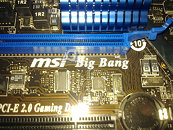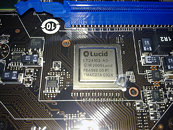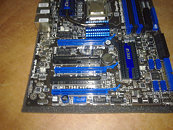Tuesday, August 11th 2009

MSI ''Big Bang'' P55 Motherboard Implements Lucid Hydra
MSI already has its task cut out when Intel's first socket LGA-1156 processors hit stores. With entry-level P55-CD53, mid-range P55-GD65, enthusiast-range P55-GD80, and a micro-ATX P55M-GD45 motherboard offering in place, the lineup seems just about complete, except for two mysterious motherboards that aren't part of the list. First being the G9P55-DC that packs an NVIDIA BR-03 bridge chip that enables 3-way SLI with better interface bandwidth to the three graphics cards, and second is under the looking-glass today. Codenamed "Big Bang", this prototype motherboard by MSI packs a LucidLogix Hydra technology, which clearly on paper, is the next big thing as far as multi-GPU systems go.
MSI P55 "Big Bang" looks similar to the P55-GD80, except for that under the top chipset heatsink (which, by the way, is purely cosmetic on the GD80), is a Lucid Hydra chip. The chip connects to all three (or four) PCI-Express x16 slots (lane configuration not known), and allows Lucid's multi-GPU technology that lets you make practically any combination of graphics cards, for performance scaling. The member cards needn't have parity on their performance, as the Hydra chip does all the load-balancing by itself. Products based on Hydra are slowly, but surely showing up in small numbers for now, including enterprise-grade rack-mount graphics rendering boxes like this one, conceived a long time ago. A lot of details are yet to emerge, especially around if there are more motherboard manufacturers eying Hydra, about when a Hydra-based product actually makes it to shelves, and more importantly, when does MSI plan to sell this and G9P55-DC.
Source:
IOPanel
MSI P55 "Big Bang" looks similar to the P55-GD80, except for that under the top chipset heatsink (which, by the way, is purely cosmetic on the GD80), is a Lucid Hydra chip. The chip connects to all three (or four) PCI-Express x16 slots (lane configuration not known), and allows Lucid's multi-GPU technology that lets you make practically any combination of graphics cards, for performance scaling. The member cards needn't have parity on their performance, as the Hydra chip does all the load-balancing by itself. Products based on Hydra are slowly, but surely showing up in small numbers for now, including enterprise-grade rack-mount graphics rendering boxes like this one, conceived a long time ago. A lot of details are yet to emerge, especially around if there are more motherboard manufacturers eying Hydra, about when a Hydra-based product actually makes it to shelves, and more importantly, when does MSI plan to sell this and G9P55-DC.



87 Comments on MSI ''Big Bang'' P55 Motherboard Implements Lucid Hydra
:skeptical:
* Now I want to know how things will work on the driver side, or if drivers will be needed at all?
and it came just in time for direct x 11 too XD
I remember they said they would make a pci/pci-e add in card version of this, I would buy it in a minute if this is good.
Either way, if this actually does work, BIG props to the engineers behind this, but I just can't see it working... I suspect lots of crashes, blue screens, performance issues, etc. However they would have to make thier own drivers for running Nvidia and ATi cards togeather, since you can't have Nvidia and ATi drivers running togeather on Vista or 7.
Hm... blurry picture is blurry. Could this be a fake?
Big Bang BSOD!
maybe its just my eyes lol
(that is if it makes it to retail)
Seems like a better implementation of SLI/CFX - something that won't depend on games being optimized or not. Amen to that.
But I think this is vaporware.
Added stage means another performance degradation. :rolleyes:
A penny-pinching enthusiast's mobo. Parting with moolah$$, so as to use low-end gpus.